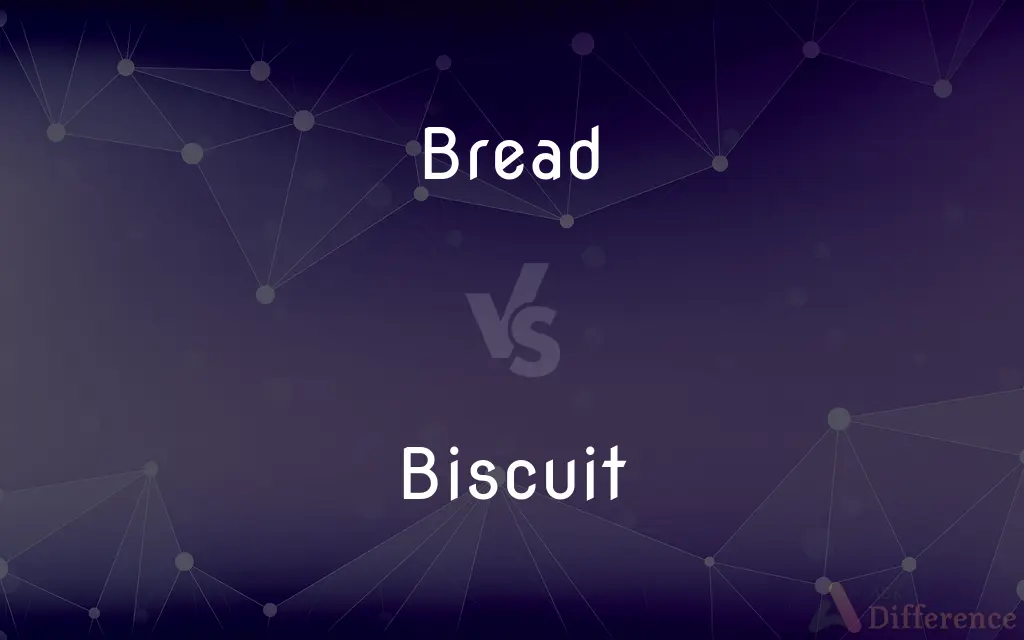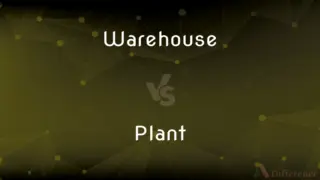Bread vs. Biscuit — What's the Difference?
By Tayyaba Rehman & Urooj Arif — Updated on May 2, 2024
Bread, typically soft and fluffy, is made from flour, water, and yeast; biscuits are usually firm, flaky treats baked from a dough that includes fat like butter.

Difference Between Bread and Biscuit
Table of Contents
ADVERTISEMENT
Key Differences
Bread is a staple food in many cultures, made by baking a dough of flour and water and often including yeast to allow the dough to rise. Biscuits, on the other hand, are a type of quick bread that does not typically use yeast, relying instead on a leavening agent like baking powder to help them rise quickly during baking.
Bread usually has a soft and airy texture with a crusty exterior, thanks to the yeast fermentation process that produces carbon dioxide. Whereas biscuits are known for their flaky and crumbly texture, achieved through layers of fat that are kept cold and not fully mixed into the dough.
The making of bread can be a time-consuming process involving proofing and kneading to develop gluten, which gives bread its chewy texture. Biscuits are prepared with minimal handling of the dough to prevent the activation of gluten, ensuring they remain tender and soft.
Bread is commonly consumed as a side dish or used as the base for sandwiches with various fillings. In contrast, biscuits might be served as a side dish too, but are also popularly consumed as a sweet snack or dessert, especially when topped with jam, gravy, or honey.
Bread dough is typically baked in a preheated oven at a consistent temperature, which allows the loaf to develop a golden crust and soft interior. On the other hand, biscuits are baked at a higher temperature for a shorter duration to achieve a light golden top while maintaining a moist center.
ADVERTISEMENT
Comparison Chart
Ingredients
Flour, water, yeast, salt
Flour, baking powder, butter, milk
Texture
Soft, chewy interior with crusty exterior
Flaky, crumbly, and tender
Leavening Agent
Yeast (ferments slowly)
Baking powder (acts quickly)
Preparation Time
Longer, requires proofing
Quicker, no proofing needed
Common Uses
Sandwiches, toast, side dish
Desserts, snacks, side dish
Compare with Definitions
Bread
In many cultures, bread is considered a staple food.
Bread is a staple in European diets.
Biscuit
The texture of a biscuit should be flaky and light.
The secret to flaky biscuits is very cold butter.
Bread
Bread can be enriched with ingredients like nuts, seeds, and fruits.
The walnut bread had a delightful crunch.
Biscuit
A small, typically round cake of bread leavened with baking powder.
She served warm biscuits with dinner.
Bread
A food made by baking dough of flour and water, commonly leavened by yeast.
She baked fresh bread for breakfast.
Biscuit
Often eaten as a snack or with tea.
Biscuits are often enjoyed with afternoon tea.
Bread
Bread varieties can range from flat to fluffy.
Pita, a type of flatbread, is popular in Middle Eastern cuisine.
Biscuit
Biscuits can be sweet or savory depending on added ingredients.
Cheese biscuits are a delightful savory treat.
Bread
Slices of bread are often used to make sandwiches.
He prefers turkey sandwiches on whole wheat bread.
Biscuit
In the US, biscuits are fluffy and served with meals.
Biscuits and gravy are a traditional Southern breakfast.
Bread
Bread is a staple food prepared from a dough of flour and water, usually by baking. Throughout recorded history, it has been a prominent food in large parts of the world.
Biscuit
A biscuit is a flour-based baked food product. In most countries, particularly in the Commonwealth and Ireland, biscuits are typically hard, flat and unleavened.
Bread
A staple food made from flour or meal mixed with other dry and liquid ingredients, usually combined with a leavening agent, and kneaded, shaped into loaves, and baked.
Biscuit
A small baked unleavened cake, typically crisp, flat, and sweet
A chocolate biscuit
Bread
Food in general, regarded as necessary for sustaining life
"If bread is the first necessity of life, recreation is a close second" (Edward Bellamy).
Biscuit
Porcelain or other pottery which has been fired but not glazed
Biscuit ware
Bread
Something that nourishes; sustenance
"My bread shall be the anguish of my mind" (Edmund Spenser).
Biscuit
A light brown colour.
Bread
Means of support; livelihood
Earn one's bread.
Biscuit
A small flat piece of wood used to join two larger pieces of wood together, fitting into slots in each.
Bread
(Slang) Money.
Biscuit
A small cake of shortened bread leavened with baking powder or soda.
Bread
To coat with bread crumbs, as before cooking
Breaded the fish fillets.
Biscuit
A thin, crisp cracker.
Bread
(uncountable)
Biscuit
A cookie.
Bread
A foodstuff made by baking dough made from cereals.
We made sandwiches with the bread we bought from the bakery.
Any leftover bread can be put into the pudding.
Biscuit
A hard, dry cracker given to dogs as a treat or dietary supplement.
Bread
Food; sustenance; support of life, in general.
Biscuit
A thin, often oblong, waferlike piece of wood, glued into slots to connect larger pieces of wood in a joint.
Bread
(countable) Any variety of bread.
Biscuit
A pale brown.
Bread
Money.
Biscuit
Pl. biscuit Clay that has been fired once but not glazed. Also called bisque2.
Bread
Breadth.
Biscuit
A small, flat, baked good which is either hard and crisp or else soft but firm; a cookie.
Bread
A piece of embroidery; a braid.
Biscuit
A small, usually soft and flaky bread, generally made with baking soda, which is similar in texture to a scone but which is usually not sweet.
Bread
(transitive) To coat with breadcrumbs.
Breaded fish
Biscuit
A cracker.
Cheese and biscuits
Water biscuits
Digestive biscuits
Bread
To make broad; spread.
Biscuit
(nautical) The "bread" formerly supplied to naval ships, which was made with very little water, kneaded into flat cakes, and slowly baked, and which often became infested with weevils.
Bread
(transitive) To form in meshes; net.
Biscuit
A form of unglazed earthenware.
Bread
To spread.
Biscuit
A light brown colour.
Bread
To cover with bread crumbs, preparatory to cooking; as, breaded cutlets.
Biscuit
(woodworking) A thin oval wafer of wood or other material inserted into mating slots on pieces of material to be joined to provide gluing surface and strength in shear.
Bread
An article of food made from flour or meal by moistening, kneading, and baking.
Biscuit
A plastic card bearing the codes for authorizing a nuclear attack.
Bread
Food; sustenance; support of life, in general.
Give us this day our daily bread.
Biscuit
A handgun, especially a revolver.
Bread
Food made from dough of flour or meal and usually raised with yeast or baking powder and then baked
Biscuit
A puck (hockey puck).
Bread
Informal terms for money
Biscuit
(slang) The head.
Bread
Cover with bread crumbs;
Bread the pork chops before frying them
Biscuit
A kind of unraised bread, of many varieties, plain, sweet, or fancy, formed into flat cakes, and bakes hard; as, ship biscuit.
According to military practice, the bread or biscuit of the Romans was twice prepared in the oven.
Biscuit
A small loaf or cake of bread, raised and shortened, or made light with soda or baking powder. Usually a number are baked in the same pan, forming a sheet or card.
Biscuit
Earthen ware or porcelain which has undergone the first baking, before it is subjected to the glazing.
Biscuit
A species of white, unglazed porcelain, in which vases, figures, and groups are formed in miniature.
Biscuit
Small round bread leavened with baking-powder or soda
Biscuit
Any of various small flat sweet cakes (`biscuit' is the British term)
Common Curiosities
Are biscuits considered a healthy snack?
Biscuits can be high in fats and sugars, so they are often considered less healthy than other snacks.
What is the primary leavening agent in bread?
Yeast is the primary leavening agent in bread.
Is bread a good source of carbohydrates?
Yes, bread is a significant source of carbohydrates.
What are common flavors added to biscuits?
Common biscuit flavors include cheese, garlic, and cinnamon.
What makes the texture of biscuits different from bread?
The texture of biscuits is flakier and crumblier than bread due to the presence of cold fat and less gluten formation.
Can biscuits be frozen for later use?
Yes, biscuits can be frozen either before or after baking for later use.
Can biscuits be made without a leavening agent?
No, biscuits typically require a leavening agent like baking powder to rise.
What type of bread is good for making sandwiches?
Sliced whole wheat or white bread is commonly used for sandwiches due to its firmness and flavor.
Are biscuits served hot or cold?
Biscuits are usually served hot and are often best when fresh.
How long does it take to bake bread?
It typically takes about 20-30 minutes to bake bread, depending on the size and type.
What types of bread are there?
There are many types of bread, including whole grain, white, sourdough, and rye.
Can bread be made without yeast?
Yes, some breads like flatbreads do not require yeast.
What is the best way to store bread to keep it fresh?
Bread is best stored in a cool, dry place and can be kept in a bread box or wrapped in a cloth to maintain freshness.
What is a common mistake when making biscuits?
A common mistake is overworking the dough, which can lead to tough biscuits.
How does the preparation of bread and biscuits differ?
Bread preparation involves kneading and proofing, while biscuit dough is mixed lightly without proofing.
Share Your Discovery

Previous Comparison
Gaslighting vs. Lying
Next Comparison
Warehouse vs. PlantAuthor Spotlight
Written by
Tayyaba RehmanTayyaba Rehman is a distinguished writer, currently serving as a primary contributor to askdifference.com. As a researcher in semantics and etymology, Tayyaba's passion for the complexity of languages and their distinctions has found a perfect home on the platform. Tayyaba delves into the intricacies of language, distinguishing between commonly confused words and phrases, thereby providing clarity for readers worldwide.
Co-written by
Urooj ArifUrooj is a skilled content writer at Ask Difference, known for her exceptional ability to simplify complex topics into engaging and informative content. With a passion for research and a flair for clear, concise writing, she consistently delivers articles that resonate with our diverse audience.
















































